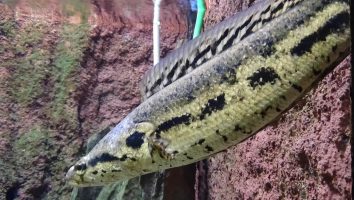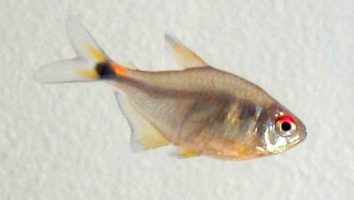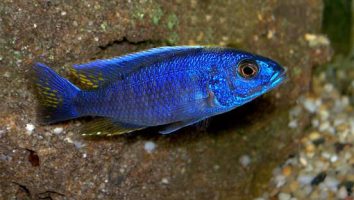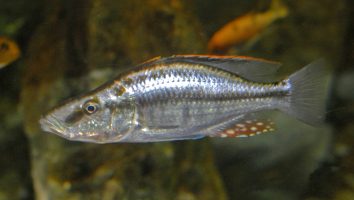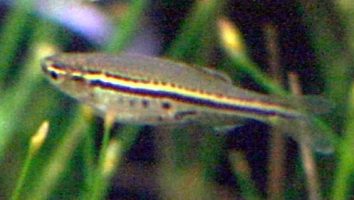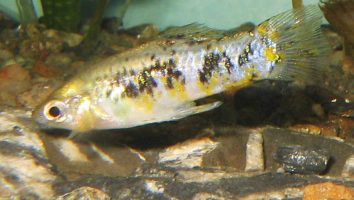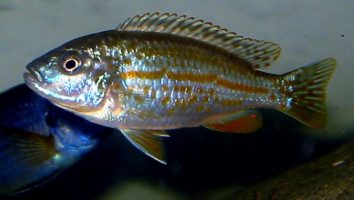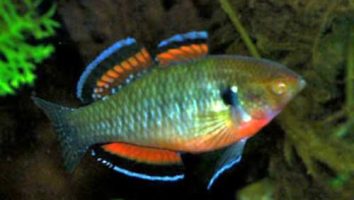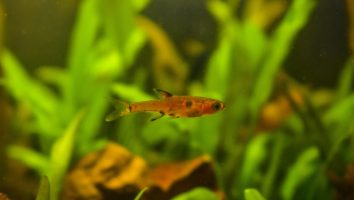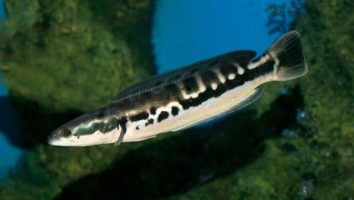The pale usisya aulonocara is a stunning freshwater fish that is native to Lake Malawi in Africa.
This species is not commonly found in the aquarium trade, but is becoming more popular among hobbyists.
If you’re looking for a fish that is both beautiful and relatively easy to care for, the pale usisya aulonocara is a great choice!
In this guide, we will teach you everything you need to know about pale usisya aulonocara care. You’ll learn about their diet, tank mates, size, and more!
Table of contents
Species overview
The Pale usisya aulonocara (Aulonocara stuartgranti “usisya”) is a species of cichlid fish that is native to Lake Malawi in East Africa.
This fish is part of the Haplochromini tribe which contains some of the most colorful freshwater fish in the world. The Pale usisya aulonocara is no exception and is known for its beautiful blue coloration.
This fish prefers to live in areas with a lot of rocks and hiding places. This is because they are quite shy and need places to hide when they feel threatened.
The Pale usisya aulonocara is a peaceful fish that is compatible with a wide variety of tank mates. However, they should not be kept with fish that are much larger than them as they may become scared and stressed.
Appearance
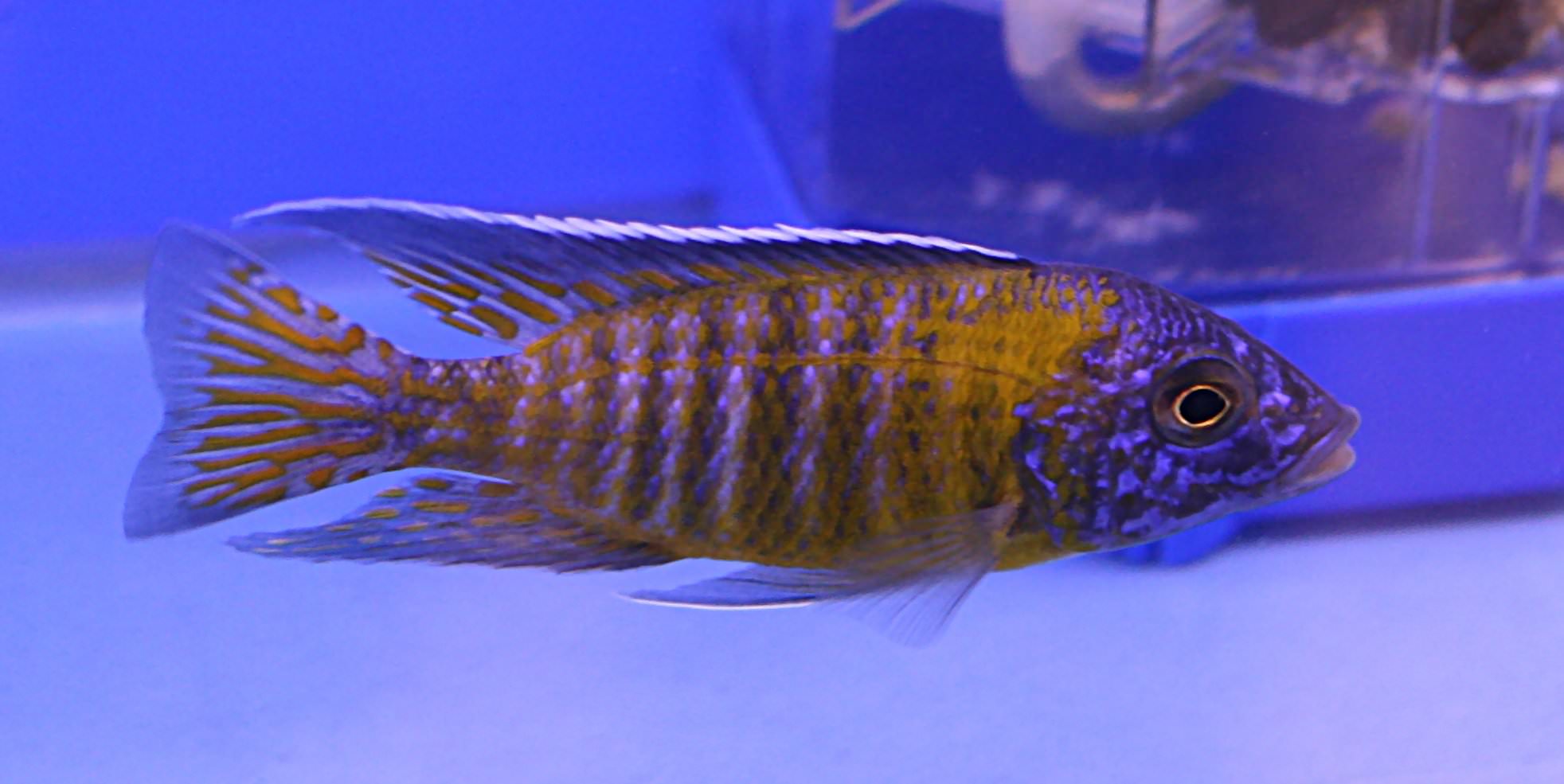
The body shape of this fish is very similar to other Aulonocara species. They have a long, slender, and torpedo-shaped body that is relatively symmetrical. The males tend to be a bit larger than the females and they also have more coloration.
The fins on this fish are also similar to other Aulonocara species. They have a moderately sized dorsal fin that starts about two-thirds of the way back on their body. The anal fin is a bit smaller and also starts around the same area. Both of these fins are relatively tall and thin.
The caudal fin is forked and symmetrical on both the top and bottom. The pectoral fins are also moderately sized and begin near the gill plates.
The most notable feature of this fish is their coloration. The body of the fish is a pale blue with some light stripes running down the middle.
The fins are translucent with a bit of blue coloration. The males tend to be more colorful overall with brighter fins.
Lifespan
The lifespan of a Pale usisya aulonocara in captivity is typically around 10 years. Of course, this can differ based on the quality of care they receive.
As with most fish, the Pale usisya aulonocara is very sensitive to water quality. If the water in their tank is not properly maintained, it can shorten their lifespan significantly.
Additionally, these fish are known to be susceptible to a number of diseases. If they contract one of these diseases, it can also shorten their lifespan.
Size
The average size of a Pale usisya aulonocara is about 4-5 inches.
Tank
Tank Size
The recommended tank size for aulonocara is 75 gallons. This is due to their large size and their active swimming habits.
Aulonocara are also known to be quite aggressive so you will need to provide enough space for them to have their own territory. It is also a good idea to have plenty of hiding places in the tank for the less aggressive fish.
Water Parameters
The Pale usisya aulonocara is a beautiful and popular freshwater fish. They’re relatively easy to care for, but like all fish, they have specific water parameters that must be met in order to stay healthy.
Pale usisya aulonocara come from Lake Malawi in Africa. The water in Lake Malawi is very alkaline with a pH between 7.8 and 8.6. The temperature ranges from 72 to 82 degrees Fahrenheit.
While you don’t need to match the exact water parameters of their natural habitat, you should try to stay as close as possible.
- Water Temperature: 72°F to 82°F
- pH Levels: 7.8 to 8.6
- Water Hardness: 8 to 30 dGH
- Alkalinity Levels: 8-12 dKH
What To Put In Their Tank
When it comes to setting up an aquarium for Pale usisya aulonocara, there are a couple of things you should keep in mind.
First, these fish come from Lake Malawi. This means that the water in their natural habitat is incredibly hard and alkaline (pH around 8.5).
You’ll need to replicate these conditions as best you can in your aquarium. The easiest way to do this is to use a Rift Lake cichlid salt mix. This will help to harden the water and raise the pH to the correct level.
The second thing to keep in mind is that these fish love to dig. They’ll spend a lot of time sifting through the substrate looking for food.
Because of this, you’ll want to use a fairly fine substrate. We recommend sand over gravel since it’s less likely to damage their delicate fins.
You can also add some rocks and driftwood to the inside of their tank. Just avoid anything too sharp or jagged since it could injure them.
Plants are a bit of a hit or miss with this species. Some aquarists have success while others end up with a tank full of uprooted plants. If you want to give it a go we recommend using tough plants like Java fern or Anubias.
Common Diseases
While they are rather hardy, there are still a few diseases that you need to watch out for with your Pale usisya aulonocara.
The most common one is ich. This is a parasites that can cause a lot of problems for your fish if it’s not treated quickly. The most obvious symptom is the presence of white spots on the body of your fish.
If you notice this, it’s important to take action immediately. Ich can quickly spread and kill your fish if it’s left unchecked.
Other potential diseases include hole-in-the-head, gill flukes, and skin flukes. These are all rather uncommon but can still affect your fish if the conditions are right.
As always, the best way to prevent these diseases is to maintain a clean and stable tank. This will go a long way in keeping your Pale usisya aulonocara healthy and disease-free.
Behavior & Temperament
The Pale usisya aulonocara is a peaceful fish that is known to be a great addition to any community tank. These fish are relatively timid, so they may not be the first to come out and explore their new surroundings.
Instead, they’ll likely spend the first few days in your tank hiding behind rocks or plants. Once they get acclimated to their new home, they’ll start to come out more and may even swim in the open water column.
Pale usisya aulonocara are known to be gentle fish. They generally get along well with other tank mates and won’t bother other fish unless they feel threatened. If they do feel threatened, they may try to defend themselves with their sharp fins.
Tank Mates
The best tank mates for Pale usisya aulonocara are other peaceful cichlids from Lake Malawi. These fish are used to living in groups, so they do best when they have company.
Pale usisya aulonocara are also used to living in rocky habitats. As a result, they appreciate tanks with plenty of hiding places. This gives them a place to retreat when they need some alone time.
Some good tank mates for Pale usisya aulonocara include:
- Auratus Cichlid
- Demasoni Cichlid
- Kenyi Cichlid
- Powder Blue Cichlid
- Red Zebra Cichlid
- Yellow Lab Cichlid
Breeding
The pale usisya aulonocara is a beautiful and relatively easy to breed cichlid. They are maternal mouthbrooders, which means the female will carry the eggs and fry in her mouth until they are free-swimming and can fend for themselves.
To get started, you will need to set up a breeding tank. It should be at least 30 gallons and have a sandy bottom. Add some rocks and caves for hiding places and to provide some surface area for the female to lay her eggs.
The water should be soft (around 5 dGH) and slightly acidic (pH 6.5-7.0). The temperature should be between 75 and 82 degrees Fahrenheit.
When ready, add one male and two or three females to the tank. The male will be the one with the more colorful fins.
Once the fish have acclimated, you can begin feeding them live foods. This will help to bring out their colors and get them in breeding condition.
When the female is ready to spawn, she will lay her eggs on a flat surface like a rock. The male will then fertilize them.
Once the eggs have been fertilized, the female will pick them up in her mouth and carry them around until they hatch. This process usually takes about two weeks.
Once the fry have hatched, they will stay in the mother’s mouth for another two weeks or so. After that, they will be released and should be able to fend for themselves.
You can start feeding the fry live foods like brine shrimp or bloodworms. You can also give them crushed flake food.
Conclusion
The Pale usisya aulonocara is a beautiful fish that is a great addition to any freshwater tank. They are peaceful and get along well with other fish, making them a perfect community fish.
They are also easy to care for, which is always a bonus.
If you’re looking for a fish that is both beautiful and low-maintenance, the Pale usisya aulonocara is a great choice!

